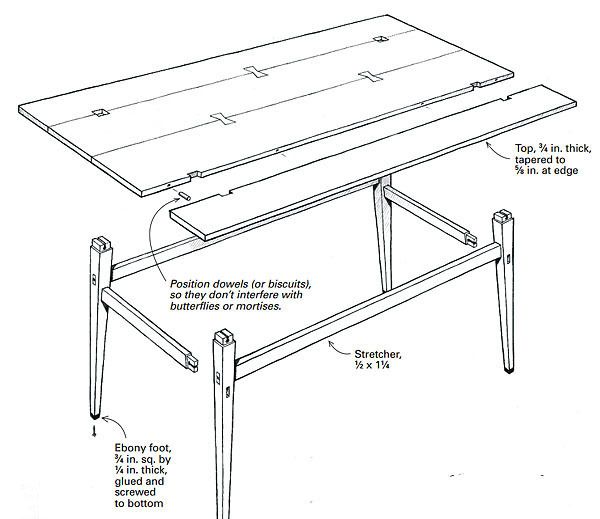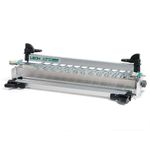Joinery for Light, Sturdy Coffee Table
Wedged through tenons and inlaid butterflies are the keys that hold it together
Synopsis: Lindsay Suter’s coffee table has exposed joinery: through-tenons, wedged with butterfly keys, join the legs to the top. Narrow stretchers replace more traditional aprons, and the tabletop is fastened directly to the legs. Top-, side-, and front-view drawings help illustrate the joinery, as does a detailed project plan, and photos show how he assembles it. Suter cuts mortises with a dado blade, and the legs are tenoned, mortised, and tapered. He lays out stretchers from the legs and assembles the frame in two steps. He uses a jig to make the butterfly keys. The piece is finished with oil and varnish.
I knew a wood supplier in California, a whacky old hippie, whose joy was salvaging trees everyone else overlooked and then turning the wood into spectacular lumber. His lumberyard may have been in complete chaos, but he had a gift for finding the raw material for truly memorable furniture. It was in these wood stacks that I found the curly cherry perfectly suited for a low coffee table I had designed.
The table, as shown in the photo on the facing page, looks quite simple. But its exposed joinery puts craftsmanship as well as the figured wood on display. Through tenons, wedged with butterfly keys, join the legs to the top. Narrow stretchers replace more traditional aprons, keeping the table looking light and airy. The design also is a little daring because the tabletop is fastened directly to the legs.
I wondered as I drew up the plans whether this feature might result in a split top. As it turns out, the frame of this table flexes slightly as the top expands and contracts across its width. This is a result of using relatively thin stretchers, only 1 ⁄2 in. thick, that are set well below the top of the frame. Because the frame isn’t absolutely rigid, the top has enough freedom of movement so it won’t split. I know because the first one I made went to a client in Massachusetts where summers are hot and humid and indoor winter conditions are bone dry. The table has been there for seven years and shows no signs of a problem. Even so, I would choose a relatively stable wood for this design. Quarter-sawn white oak, nara or myrtle wood all seem like good choices to me.
Cutting mortises with a dado blade
The top is glued up from four book-matched pieces that give the table a symmetrical quality. The leg tenons penetrate the top at the two outside joint lines. The inlaid butterfly keys let into the tops of the legs not only reinforce the joints between the top boards but also wedge the leg tenons. Cutting mortises into the tabletop where the boards are joined simplifies construction.
I cut the mortises with a dado blade and a crosscut sled on the tablesaw before gluing the top pieces together. After testing the setup on a piece of scrap, I can complete the mortises in a couple of passes.
I used dowels to align and register the edge-glued top joints. I marked the location of the butterfly keys first, so I didn’t end up with a dowel in the way later on.
From Fine Woodworking #114
For the full article, download the PDF below:
Fine Woodworking Recommended Products

Suizan Japanese Pull Saw

Circle Guide

Leigh D4R Pro






















Log in or create an account to post a comment.
Sign up Log in